Evaluating Indoor Carbon Dioxide Concentration and Ventilation Rate of Research Student Offices in Chinese Universities: A Case Study
Abstract
1. Introduction
2. Materials and Methods
2.1. Description of the Measured Room
2.2. Measuring Process
2.3. Calculation of Ventilation Rate
2.4. Model for Human CO2 Generation Rate
3. Results
3.1. Long-Term Monitoring CO2 Concentration
3.2. Air Exchange Rate of the Room by Infiltration
3.3. Indoor Occupancy Characteristics
3.4. Window/Door-Opening Behaviors of Postgraduate Students
4. Discussion
4.1. Occupancy Rate Affects Indoor CO2 Level
4.2. Opening Door/Windows Decreases Indoor CO2 Concentration
4.3. Suggestion for Ventilation in Such Rooms
4.4. Limitations
5. Conclusions
Author Contributions
Funding
Institutional Review Board Statement
Informed Consent Statement
Data Availability Statement
Acknowledgments
Conflicts of Interest
Abbreviations
| IAQ | Indoor Air Quality |
| CO2 | Carbon Dioxide |
| RH | Relative Humidity |
| RQ | Respiratory Quotient |
| ASHRAE | American Society of Heating, Refrigerating and Air-Conditioning Engineers |
References
- China’s Statistics Yearbook 2021. Available online: http://www.stats.gov.cn/tjsj/ndsj/2021/indexch.htm (accessed on 1 May 2022).
- Sarbu, I.; Pacurar, C. Experimental and numerical research to assess indoor environment quality and schoolwork performance in university classrooms. Build. Environ. 2015, 93, 141–154. [Google Scholar] [CrossRef]
- Chang, F.H.; Li, Y.Y.; Tsai, C.Y.; Yang, C.R. Specific indoor environmental quality parameters in college computer classrooms. Int. J. Environ. Res. 2009, 3, 517–524. [Google Scholar] [CrossRef]
- Jurado, S.R.; Bankoff, A.D.; Sanchez, A. Indoor air quality in Brazilian universities. Int. J. Environ. Res. Public Health 2014, 11, 7081–7093. [Google Scholar] [CrossRef] [PubMed]
- Argunhan, Z.; Avci, A.S. Statistical evaluation of indoor air quality parameters in classrooms of a university. Adv. Meteorol. 2018, 2018, 4391579. [Google Scholar] [CrossRef]
- Asif, A.; Zeeshan, M.; Jahanzaib, M. Indoor temperature, relative humidity and CO2 levels assessment in academic buildings with different heating, ventilation and air-conditioning systems. Build. Environ. 2018, 133, 83–90. [Google Scholar] [CrossRef]
- Li, H.R.; Li, X.F.; Qi, M.W. Field testing of natural ventilation in college student dormitories (Beijing, China). Build. Environ. 2014, 78, 36–43. [Google Scholar] [CrossRef]
- Zhang, N.B.; Kang, Y.M.; Zhong, K.; Liu, J.P. Indoor environmental quality of high occupancy dormitory buildings in winter in Shanghai, China. Indoor Built Environ. 2016, 25, 712–722. [Google Scholar] [CrossRef]
- Righi, E.; Aggazzotti, G.; Fantuzzi, G.; Ciccarese, V.; Predieri, G. Air quality and well-being perception in subjects attending university libraries in Modena (Italy). Sci. Total Environ. 2002, 286, 41–50. [Google Scholar] [CrossRef]
- Sulaiman, S.A.; Isa, N.; Raskan, N.I.; Harun, N.F.C. Study of indoor air quality in academic buildings of a university. Appl. Mech. Mater. 2013, 315, 389–393. [Google Scholar] [CrossRef]
- Harun, H.A.; Buyamin, N.; Othman, M.A.; Sulaiman, S.A. A case study on indoor comfort of lecture rooms in university buildings. Appl. Mech. Mater. 2013, 393, 821–826. [Google Scholar] [CrossRef]
- Giulio, M.D.; Grande, R.; Campli, E.D.; Bartolomeo, S.D.; Cellini, L. Indoor air quality in university environments. Environ. Monit. Assess. 2010, 170, 509–517. [Google Scholar] [CrossRef] [PubMed]
- Ugranli, T.; Toprak, M.; Gursoy, G.; Cimrin, A.H.; Sofuoglu, S.C. Indoor environmental quality in chemistry and chemical engineering laboratories at Izmir Institute of Technology. Atmos. Pollut. Res. 2015, 6, 147–153. [Google Scholar] [CrossRef]
- Shi, S.S.; Chen, C.; Zhao, B. Air infiltration rate distributions of residences in Beijing. Build. Environ. 2015, 92, 528–537. [Google Scholar] [CrossRef]
- Fujikawa, M.; Yoshino, H.; Takaki, R.; Okuyama, H.; Hayashi, M.; Sugawara, M. Experimental study of the multi-zonal airflow measurement method using human expiration. J. Environ. Eng. 2010, 75, 499–508. [Google Scholar] [CrossRef][Green Version]
- Lawrence, T.M.; Braun, J.E. A methodology for estimating occupant CO2 source generation rates from measurements in small commercial buildings. Build. Environ. 2007, 42, 623–639. [Google Scholar] [CrossRef]
- ASHRAE Handbook Fundamentals; American Society of Heating, Air Conditioning and Refrigeration Engineers: Atlanta, GA, USA, 2013.
- ANSI/ASHRAE Standard 62.1; Ventilation for Acceptable Indoor Air Quality. American Society of Heating, Refrigerating and Air-Conditioning Engineers, Inc.: Atlanta GA, USA, 2013.
- GB/T 18883; Indoor Air Quality Standard. Ministry of Environmental Protection of the People’s Republic of China: Beijing, China, 2002.
- Building Area Index for Regular Institutions of Higher Education; Ministry of Education and National Development and Reform Commission of the People’s Republic of China: Beijing, China, 2018.
- ASTM D6245; Standard Guide for Using Indoor Carbon Dioxide Concentrations to Evaluate Indoor Air Quality and Ventilation. American Society for Testing and Materials: West Conshohocken, PA, USA, 2012.
- Sarkheil, H.; Rahbari, S. Development of case historical logical air quality indices via fuzzy mathematics (Mamdani and Takagi–Sugeno systems), a case study for Shahre Rey Town. Environ. Earth Sci. 2016, 75, 1319. [Google Scholar] [CrossRef]
- Dionovaa, B.W.; Mohammed, M.N.; Al-Zubaidi, S.; Yusuf, E. Environment indoor air quality assessment using fuzzy inference system. ICT Express 2020, 6, 185–194. [Google Scholar] [CrossRef]


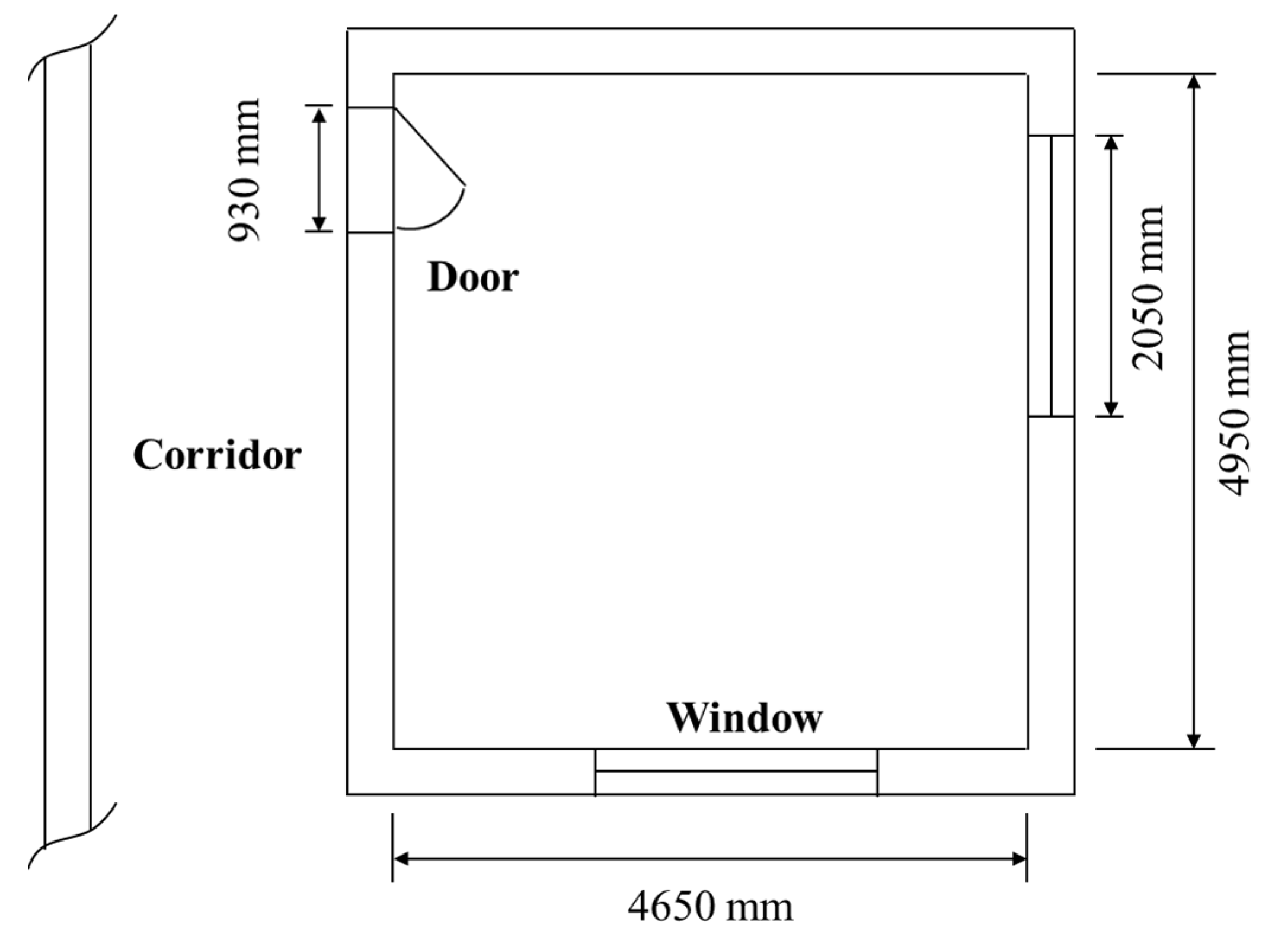

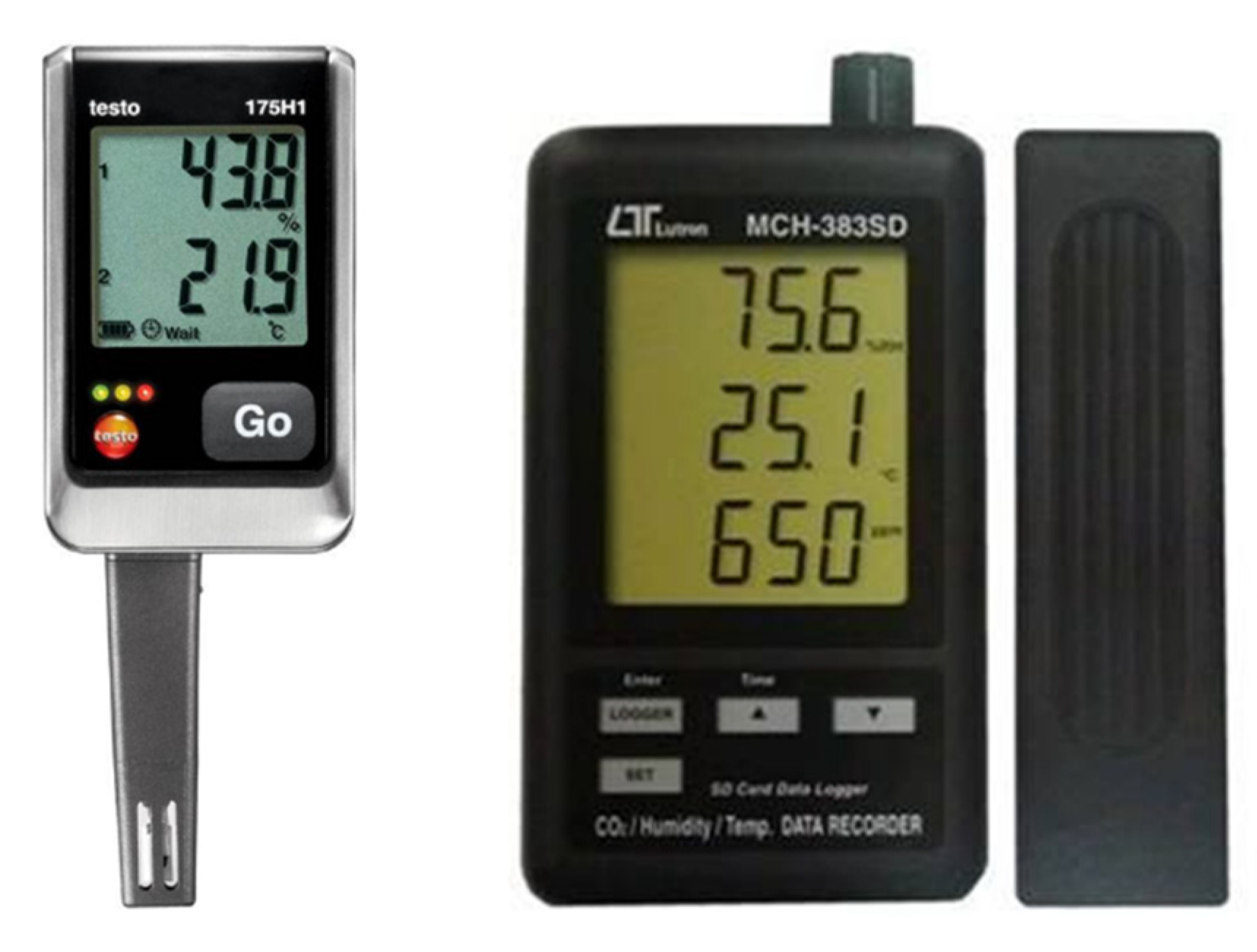
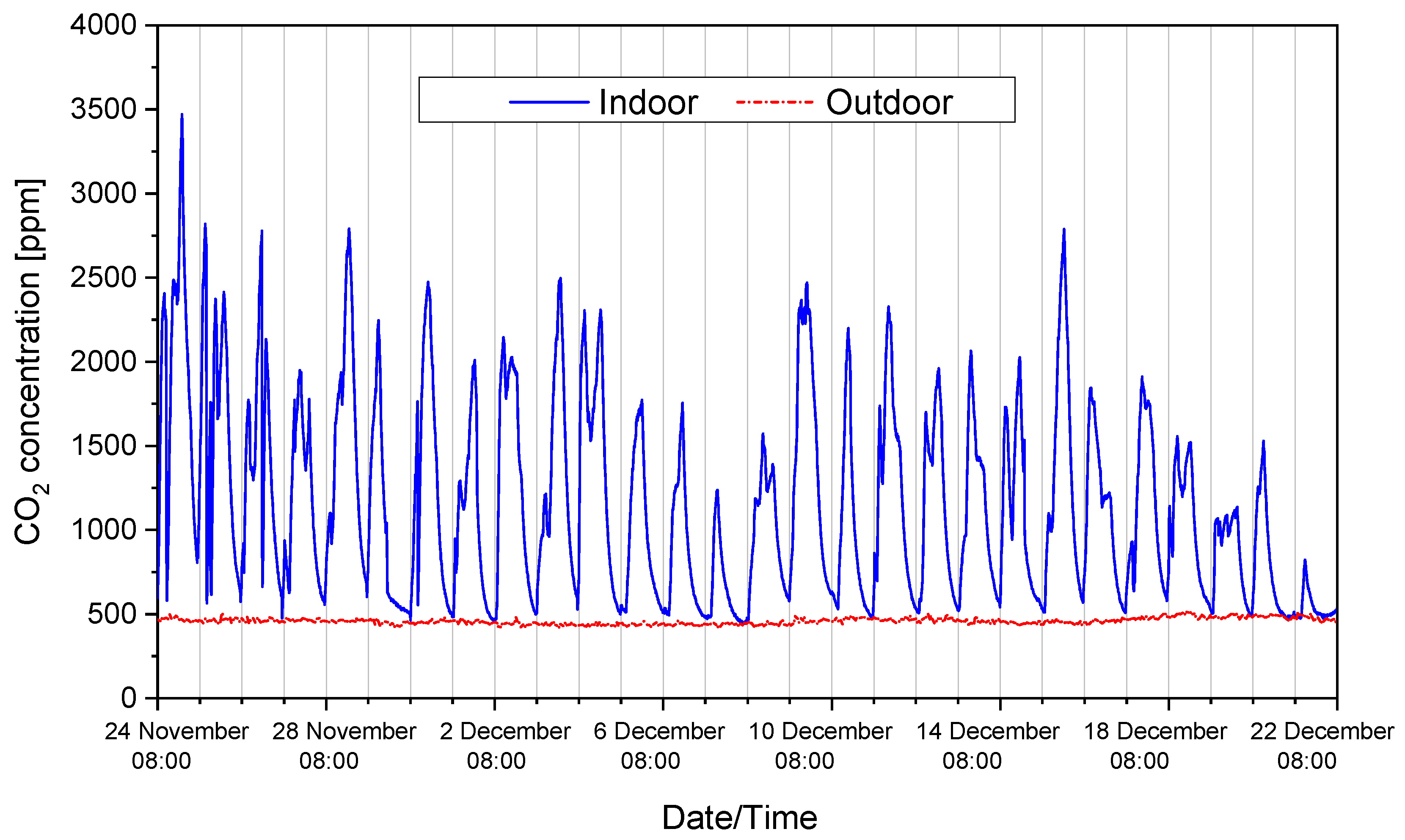
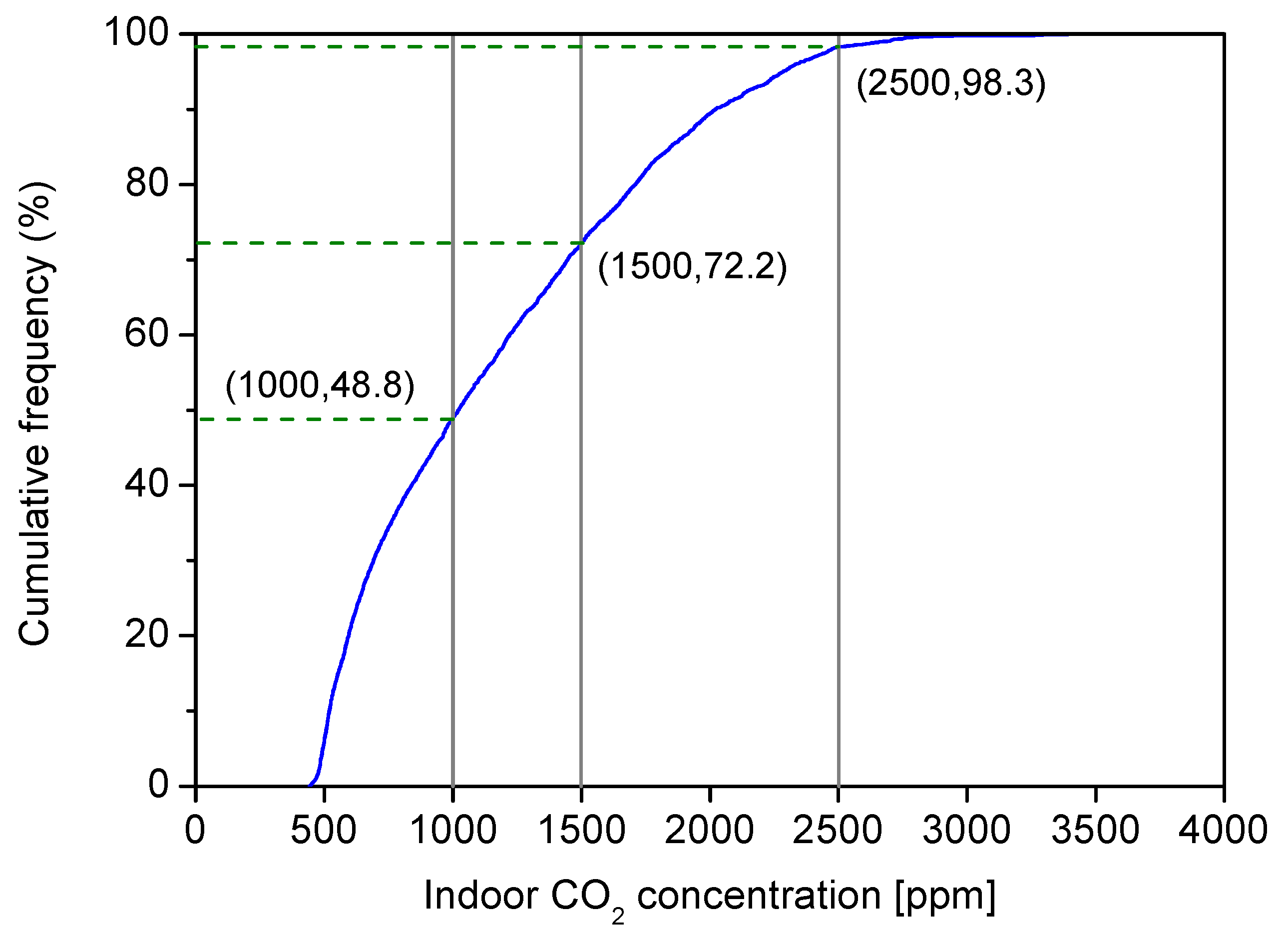
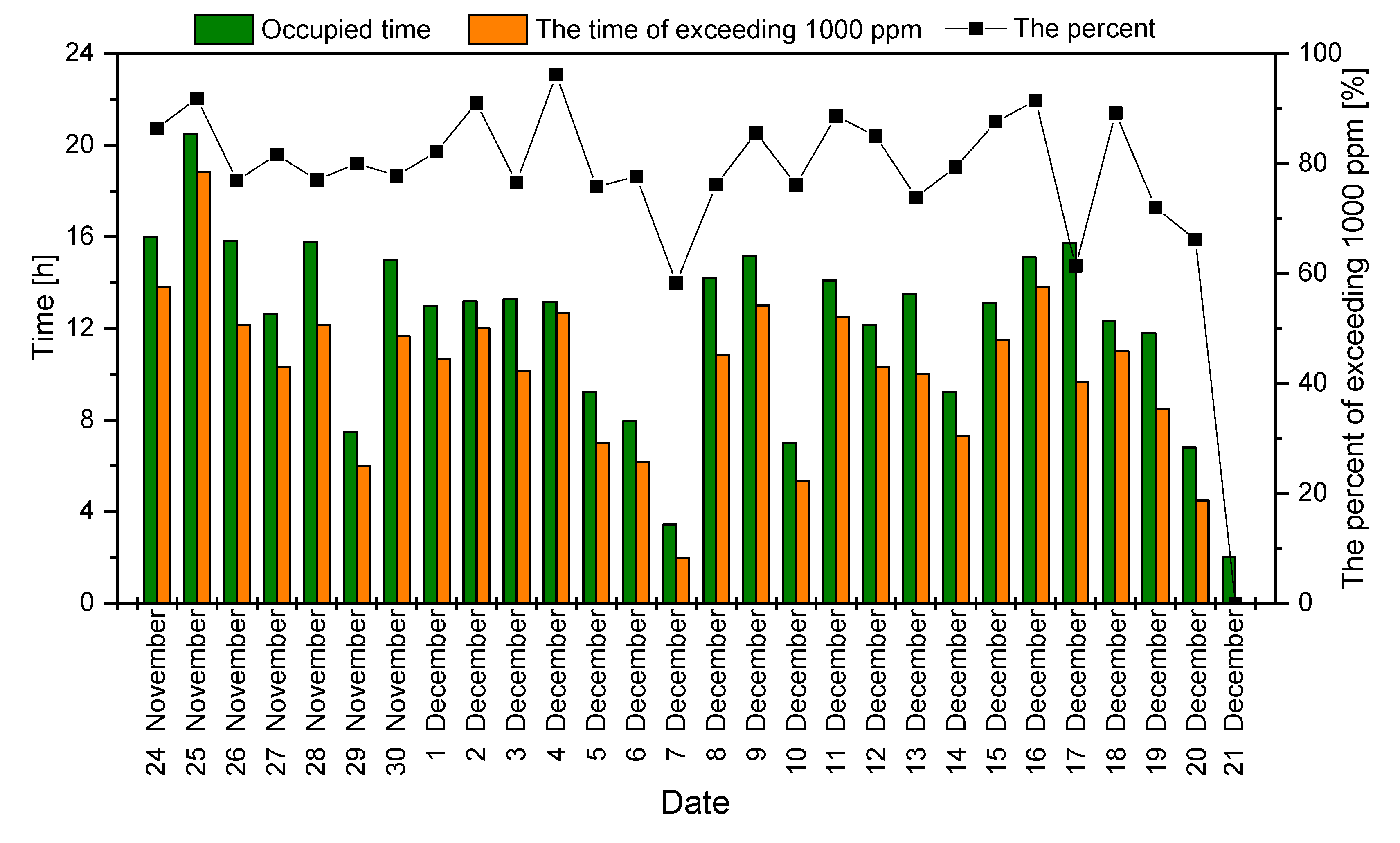
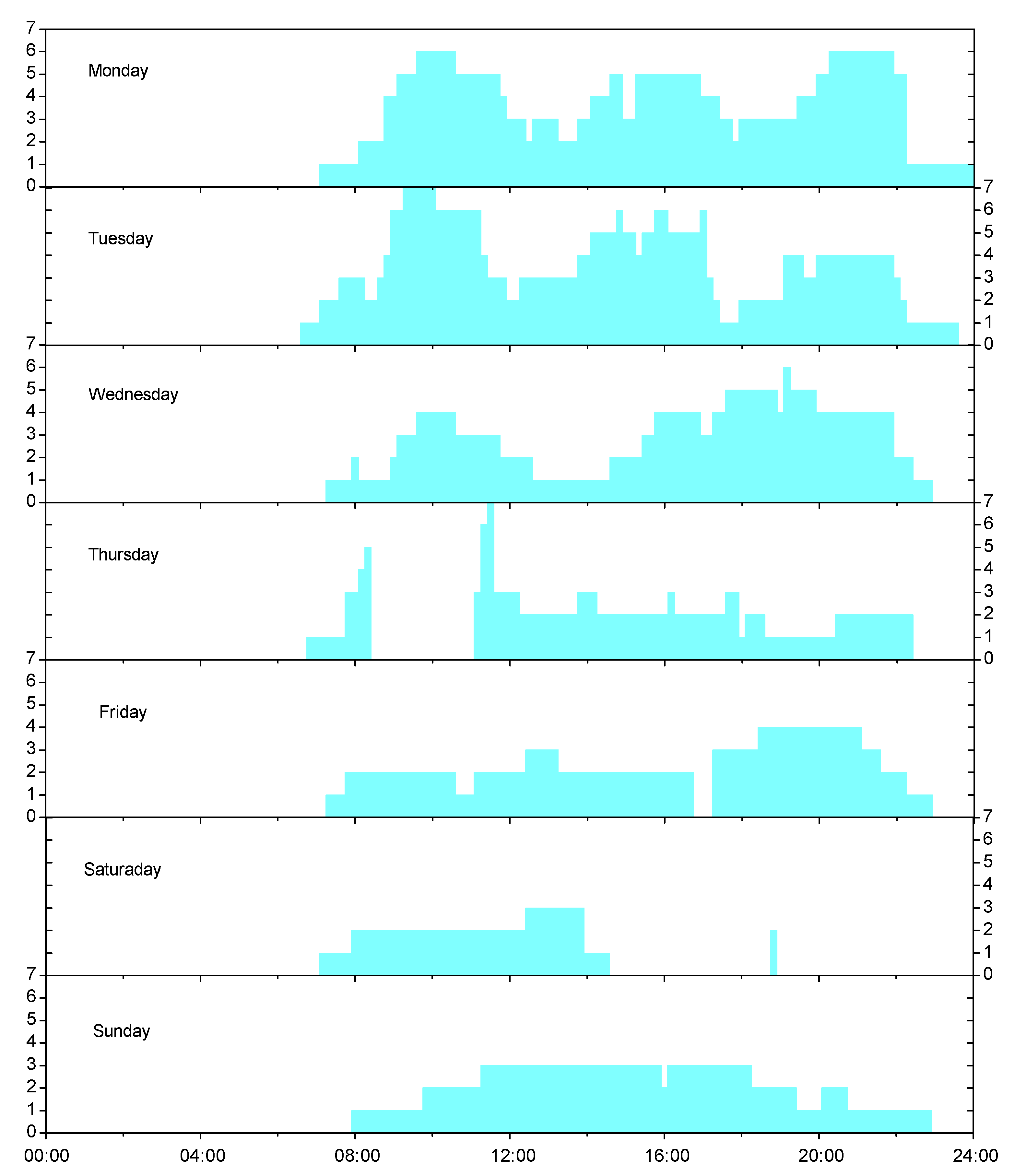
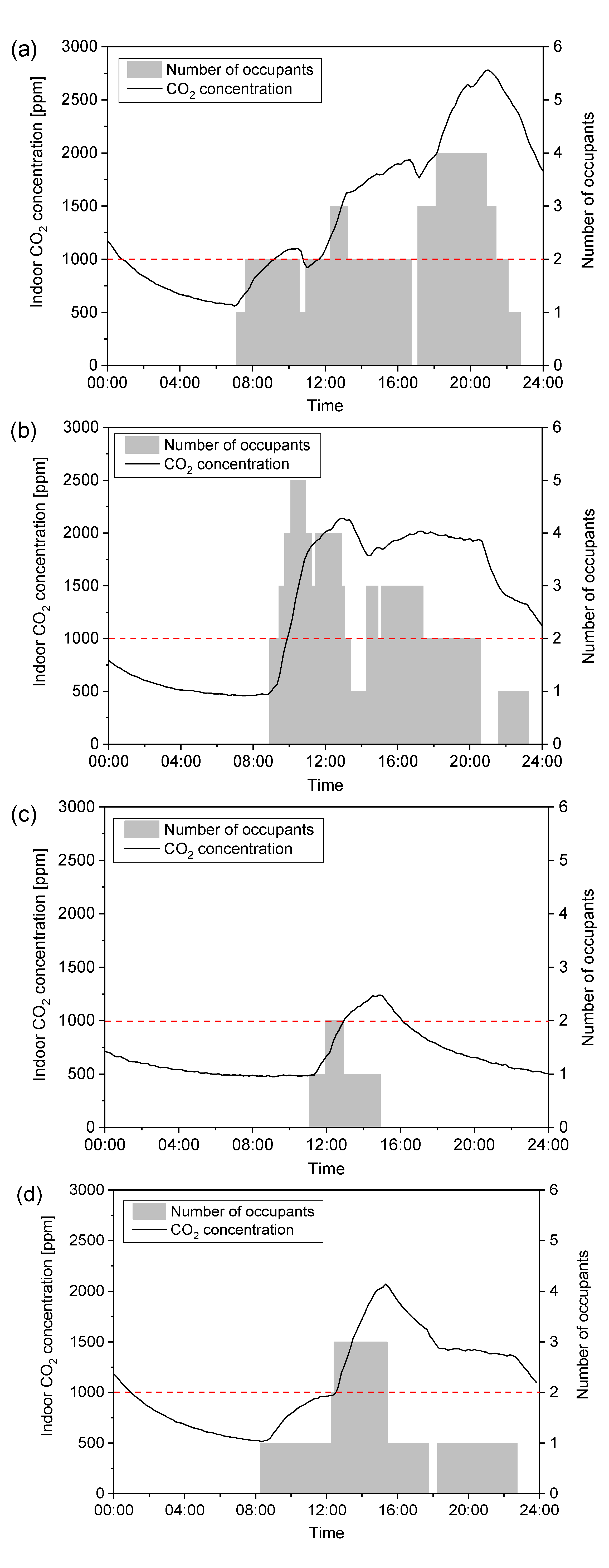

| Parameters | Range | Accuracy |
|---|---|---|
| CO2 concentration | 0–4000 ppm | ±40 ppm (below 1000 ppm) ±5% rdg (1001~3000 ppm) ±250 ppm (above 3000 ppm) |
| Indoor temperature | −20–55 °C | ±0.4 °C |
| Indoor RH | 0–100% | ±2% |
| Date | Decay Period | Initial CO2 Level [ppm] | Final CO2 Level [ppm] | AER [h−1] | Adj. R2 |
|---|---|---|---|---|---|
| 24 November | - | - | - | - | |
| 25 November | 03:10–06:20 | 1500 | 828 | 0.332 | 0.9987 |
| 26 November | 00:00–07:00 | 1777 | 643 | 0.303 | 0.9975 |
| 27 November | 00:00–06:20 | 1506 | 615 | 0.291 | 0.9986 |
| 27 November | 23:00–06:00 | 1474 | 586 | 0.317 | 0.9968 |
| 28 November | 23:10–06:30 | 2135 | 702 | 0.271 | 0.9980 |
| 29 November | 15:00–18:00 | 1771 | 983 | 0.316 | 0.9928 |
| 30 November | 23:00–08:00 | 1373 | 484 | 0.373 | 0.9991 |
| 1 December | 22:10–07:30 | 1171 | 475 | 0.409 | 0.9989 |
| 2 December | 23:30–06:30 | 1253 | 521 | 0.343 | 0.9975 |
| 3 December | 23:10–06:00 | 1945 | 642 | 0.317 | 0.9996 |
| 4 December | 21:30–06:00 | 1924 | 538 | 0.351 | 0.9996 |
| 5 December | 20:30–05:00 | 1544 | 584 | 0.285 | 0.9961 |
| 6 December | 20:00–03:00 | 1360 | 559 | 0.320 | 0.9974 |
| 7 December | 15:30–22:30 | 1132 | 550 | 0.293 | 0.9929 |
| 8 December | 23:50–07:00 | 1150 | 597 | 0.247 | 0.9905 |
| 9 December | 23:30–07:00 | 1494 | 635 | 0.280 | 0.9911 |
| 10 December | 19:30–02:00 | 1361 | 586 | 0.306 | 0.9968 |
| 11 December | 23:10–05:30 | 1427 | 607 | 0.296 | 0.9991 |
| 12 December | 23:00–07:00 | 1459 | 550 | 0.301 | 0.9995 |
| 13 December | 23:00–06:00 | 1282 | 598 | 0.255 | 0.9954 |
| 14 December | - | - | - | - | |
| 15 December | 23:00–06:00 | 1898 | 607 | 0.325 | 0.9995 |
| 16 December | 23:10–06:10 | 1148 | 527 | 0.341 | 0.9969 |
| 17 December | 23:20–06:20 | 1449 | 605 | 0.301 | 0.9946 |
| 18 December | 21:40–05:00 | 1248 | 596 | 0.277 | 0.9914 |
| 19 December | 23:20–06:00 | 1067 | 506 | 0.376 | 0.9990 |
| 20 December | 15:00–23:50 | 1278 | 507 | 0.310 | 0.9992 |
| Days | Windows | Door | Window/Door-Opening Duration (min) | Indoor CO2 Level When Occupants Open Windows/Door (ppm) |
|---|---|---|---|---|
| 1 | x | o | 16 | 2254 |
| 2 | o | o | 12 | 2694 |
| 3 | x | o | 31 | 1759 |
| 4 | x | o | 22 | 2776 |
| 5 | o | o | 8 | 1746 |
Publisher’s Note: MDPI stays neutral with regard to jurisdictional claims in published maps and institutional affiliations. |
© 2022 by the authors. Licensee MDPI, Basel, Switzerland. This article is an open access article distributed under the terms and conditions of the Creative Commons Attribution (CC BY) license (https://creativecommons.org/licenses/by/4.0/).
Share and Cite
Fan, G.; Chang, H.; Sang, C.; Chen, Y.; Ning, B.; Liu, C. Evaluating Indoor Carbon Dioxide Concentration and Ventilation Rate of Research Student Offices in Chinese Universities: A Case Study. Processes 2022, 10, 1434. https://doi.org/10.3390/pr10081434
Fan G, Chang H, Sang C, Chen Y, Ning B, Liu C. Evaluating Indoor Carbon Dioxide Concentration and Ventilation Rate of Research Student Offices in Chinese Universities: A Case Study. Processes. 2022; 10(8):1434. https://doi.org/10.3390/pr10081434
Chicago/Turabian StyleFan, Guangtao, Haoran Chang, Chenkai Sang, Yibo Chen, Baisong Ning, and Changhai Liu. 2022. "Evaluating Indoor Carbon Dioxide Concentration and Ventilation Rate of Research Student Offices in Chinese Universities: A Case Study" Processes 10, no. 8: 1434. https://doi.org/10.3390/pr10081434
APA StyleFan, G., Chang, H., Sang, C., Chen, Y., Ning, B., & Liu, C. (2022). Evaluating Indoor Carbon Dioxide Concentration and Ventilation Rate of Research Student Offices in Chinese Universities: A Case Study. Processes, 10(8), 1434. https://doi.org/10.3390/pr10081434







